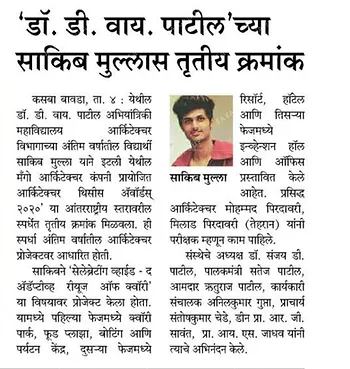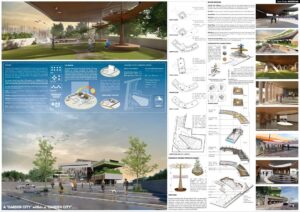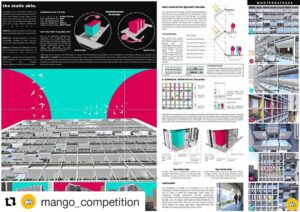Architectural Thesis of the year: ‘Third Prize’ for Quarry Rehabilitation Project
Showcasing the Future of Architecture: The Most Innovative Projects from the Architectural Thesis of the Year

Celebrating the Visionaries: Architectural Thesis of the Year Award Highlights the Boldest and Most Innovative Designs
The Architectural Thesis of the Year competition, hosted by Mango Competitions, is one of the most prestigious events in the field of architecture. This competition celebrates groundbreaking architectural ideas that push the boundaries of design while solving pressing issues within the built environment. This year, Saqib Mulla emerged as the Third Prize Winner for his project “Celebrating Void” (Quarry Rehabilitation), a design that captured the essence of innovation and environmental sustainability.
The Significance of the Award
Winning the
Winning the Architectural Thesis of the Year award is no small feat. It recognizes exceptional talent, creativity, and a profound understanding of the technical and philosophical aspects of architecture. This prestigious honor celebrates outstanding thesis projects that offer innovative solutions to complex architectural challenges, often addressing critical social, environmental, or economic factors.
In this highly competitive event, Saqib Mulla’s project stood out, earning him the Architectural Thesis of the Year award. His visionary design tackled the critical issue of quarry rehabilitation, proposing a transformative way to reimagine abandoned quarries. By turning these barren wastelands into community-benefiting spaces seamlessly integrated with the environment, his work exemplifies the innovative spirit this award celebrates.
Project Overview: “Celebrating Void” (Quarry Rehabilitation)
“Celebrating Void” is not just a design; it is a conceptual approach that redefines the relationship between nature, construction, and community. Recognized as a standout in the Architectural Thesis of the Year, this project explores how quarries, often viewed as scars on the landscape, can transform into sustainable and productive spaces.
Rather than filling or erasing these voids, Saqib’s thesis proposes celebrating their raw, natural beauty. This Architectural Thesis of the Year project envisions these spaces as hubs for creativity, interaction, and ecological restoration, turning what was once seen as a disruption into an opportunity for community and environmental rejuvenation.
Design Approach and Philosophy
Saqib Mulla’s design philosophy in “Celebrating Void” revolves around the concept of adaptive reuse. The quarry site, once used for extraction, is now repurposed to provide new opportunities for ecological rehabilitation and community involvement. The design promotes a new relationship between people and the environment, focusing on how architecture can be an agent of healing and renewal.
One of the most striking aspects of Saqib’s design, a strong contender for the Architectural Thesis of the Year, is the way he incorporates environmental sustainability. His thesis proposes a multi-layered approach that not only addresses the physical rehabilitation of the quarry but also integrates the creation of a public space for local communities. This site would host educational facilities, recreational areas, and green spaces designed to foster public engagement with nature, while also encouraging a sense of collective responsibility for environmental preservation.
The core idea behind this Architectural Thesis of the Year nominee is to take the void — a space that is often perceived negatively — and turn it into a celebration of how architecture can reconnect human beings with the environment, helping them see potential in places that are often dismissed as wastelands. Saqib’s design transforms the concept of the void into a symbol of hope, recovery, and transformation.
Project Features and Design Elements
The design features several innovative elements that make it stand out among the other entries. Some of the key features include:
Ecological Restoration: The project emphasizes restoring the quarry landscape with native plant species and sustainable land management practices. It encourages biodiversity by transforming the site into a thriving ecosystem.
Community Interaction Spaces: Saqib’s thesis includes areas where the public can interact, such as open-air classrooms, gathering spaces, and exhibition areas. These spaces aim to promote environmental awareness and community collaboration.
Sustainable Materials: The design utilizes locally sourced and eco-friendly materials, further enhancing the project’s sustainability. The buildings within the space are designed to blend seamlessly with the natural surroundings, respecting the quarry’s unique topography.
Water Management Systems: Given the quarry’s natural drainage and water features, Saqib’s design incorporates sustainable water management systems that help preserve the landscape while promoting natural hydrological cycles.
Cultural Significance: The design is also culturally significant, as it fosters local community engagement. Saqib has designed spaces that encourage cultural expression through art installations, performances, and other activities that involve the local population.
Why “Celebrating Void” Stands Out
There are many reasons why “Celebrating Void” stands out in the context of the Architectural Thesis of the Year competition. First and foremost, it addresses a critical and often overlooked issue in architecture: the rehabilitation of industrial sites that have outlived their original purpose. Quarries, once mined for resources, are often abandoned and left in a state of environmental degradation. Instead of erasing the evidence of the site’s history, Saqib’s design seeks to celebrate it and make it a functional and sustainable part of the landscape.
Additionally, the design takes a human-centered approach by creating spaces that encourage interaction, learning, and community development. It also emphasizes sustainability, not just in the materials and construction process but in the long-term ecological and social benefits it offers.
Impact of the Award on Saqib Mulla’s Career
Winning the Third Prize at the Mango Competitions Architectural Thesis of the Year is a significant milestone in Saqib Mulla’s career. It highlights his ability to think outside the box and approach complex design challenges with innovative solutions. This achievement will undoubtedly open up many doors for Saqib, allowing him to work on more prominent projects and collaborate with leading architects and firms in the future.
His project has also set a benchmark for future designers, showing that architecture is not just about creating buildings but also about restoring, healing, and engaging with the environment in a meaningful way. Saqib’s work exemplifies how architecture can be a tool for positive change and social impact.
Conclusion
Saqib Mulla’s Third Prize at the Mango Competitions Architectural Thesis of the Year award is a recognition of his exceptional talent and forward-thinking approach to design. His project, “Celebrating Void”, offers a fresh perspective on how abandoned industrial sites, particularly quarries, can be reimagined and revitalized into thriving, sustainable spaces. This thesis challenges traditional notions of what architecture should achieve and sets a powerful example of how design can serve both the environment and society.
Through this award, Saqib has demonstrated that architecture is not just about creating new spaces but about rethinking existing ones and finding solutions that benefit both people and the planet. As the design community continues to evolve, Saqib’s work will undoubtedly inspire future architects to approach challenges with the same creativity and commitment to sustainability.
https://www.mangoarchitecture.com/architectural-thesis-award-2020?pgid=kjcpvn7a-8d9bd617-13e8-4abd-843e-47c85bf9e08a
Related Posts

‘Architecture Design Competition: International Facade Design Competition by Mango Architecture Conquered by SAS3Plus Architecture

sas. secured a spot in ‘TOP 25 ENTRIES’ at ‘The Master Studio’ by Archemello Competitions India.
